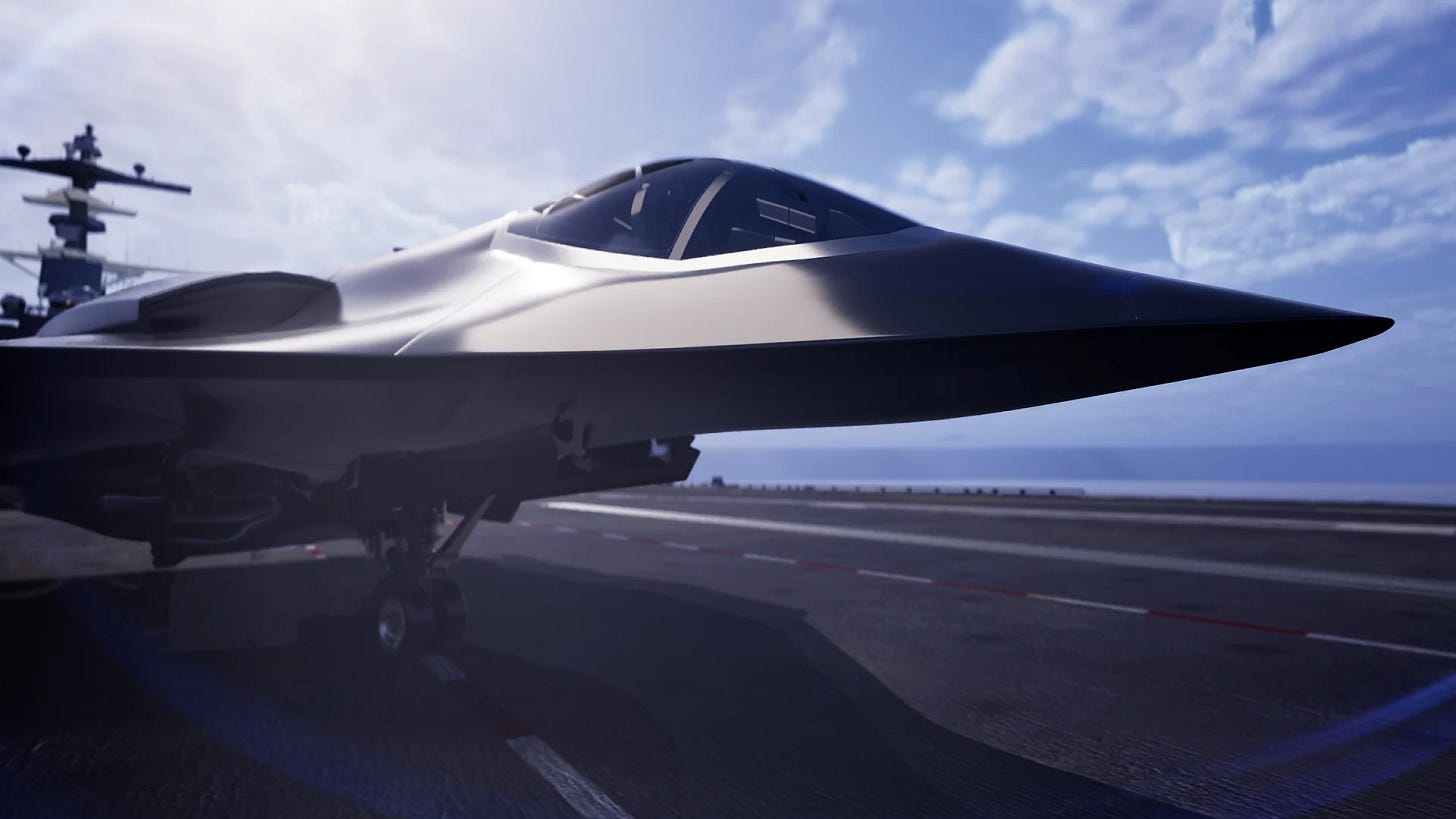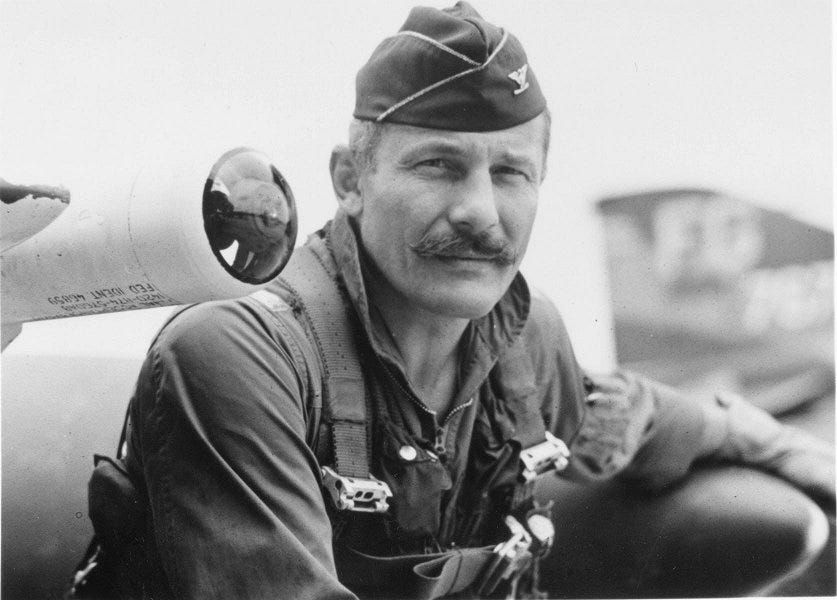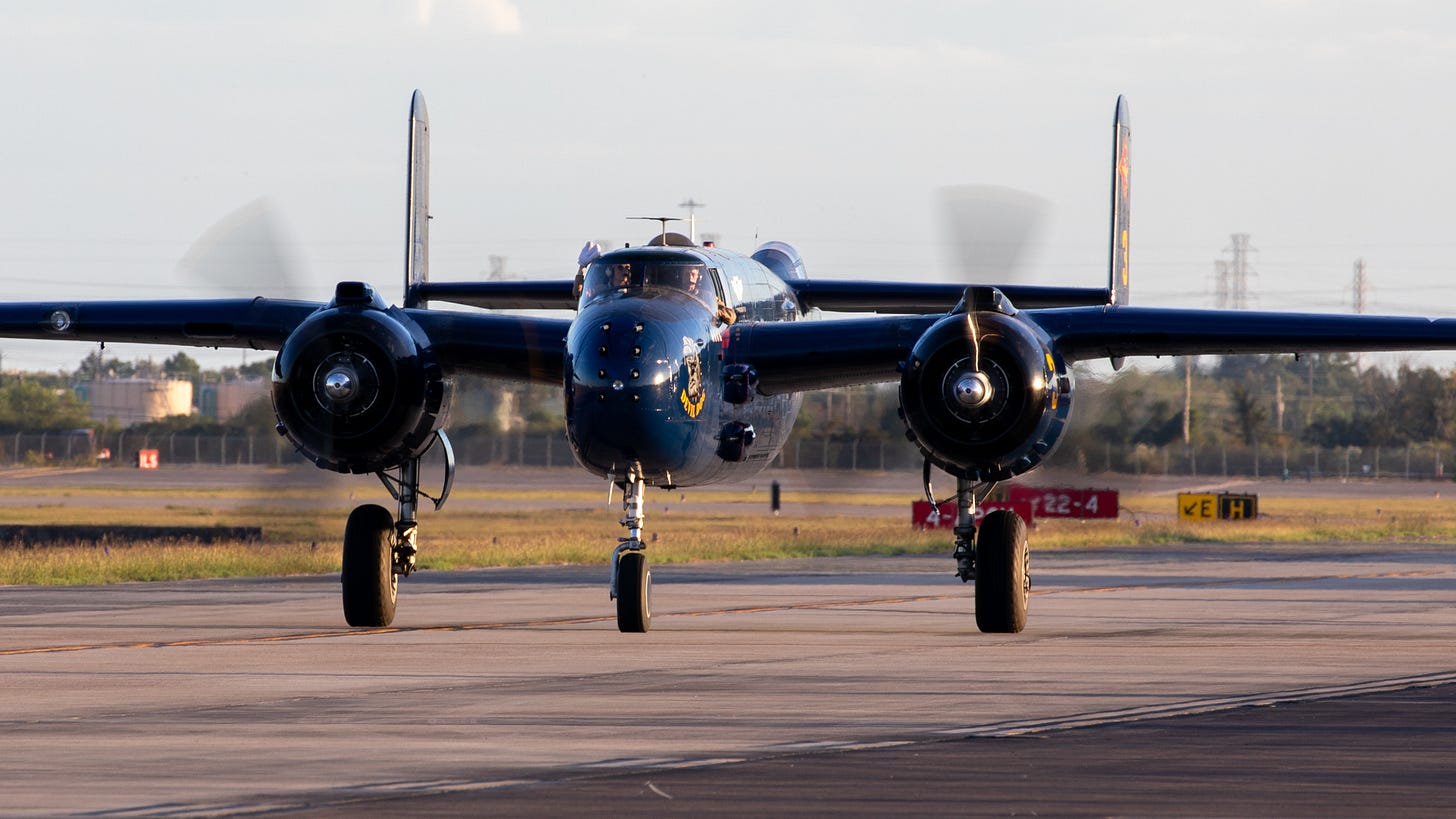Stealth Futures and Fighter Legends
From Northrop Grumman’s vision for the Navy’s next-generation F/A-XX to Robin Olds’ daring strike on the Paul Doumer Bridge, we look at the cutting edge and the timeless courage shaping airpower.
“It seemed that the naval aviation community hadn’t considered the likelihood of an F-14 engaging a helicopter. Thus, when McElraft radioed confirmation of Broce’s kill, he reported: “Uh, splash one, uhhhh…helicopter!”
- Mike Guardia (Tomcat Fury: A Combat History of the F-14)
Mission Briefing
Northrop Grumman’s F/A-XX Concept Art Deep Dive
Let me start by saying that having another Grumman (in this case Northrop Grumman) Navy fighter would be a great thing in my opinion. Having said that, lets take a deeper dive.
1. The Vision in Visual Form
Northrop Grumman has unveiled what appears to be the first official concept art for its bid in the Navy’s F/A‑XX competition, featured prominently on its Naval Aviation section—a rare glimpse into a traditionally classified program. The rendering, seen against the backdrop of an aircraft carrier deck, highlights a stealth-optimized airframe: streamlined fuselage, blending chines, and a sharply pointed nose suggesting a spacious housing for an AESA radar. Visible too are carrier-specific features like dual-wheel nose gear and a catapult launch tow bar.
2. Design Language and Stealth Features
The silhouette emphasizes low observability: heavy shadowing, smooth, radiused surfaces, and a top-mounted air intake set back behind the cockpit—a hallmark of stealth-forward engineering. Its organic form and the seamless fuse-to-wing blend indicate purposeful radar signature management.
3. Heritage of the YF-23?
Many defense analysts and commentators note a striking resemblance between this concept and the YF‑23 "Black Widow II" — Northrop’s stealth prototype from the early 1990s that competed against the YF‑22. Known for its speed, stealth, and supercruise ability, the YF‑23 serves as a possible design inspiration or spiritual forebear to the F/A‑XX.
4. Platform Role & Technical Ambitions
The F/A‑XX is not just a future fighter—it’s the centerpiece of the Navy’s NGAD Family of Systems. Its mandates include:
Multirole strike capability with air-to-air, surface, EW/RSTA, and long-range strike functions
Manned, unmanned, or optionally manned operations with seamless drone coordination
Supercruise performance, advanced sensor fusion, "smart skin" and AI-enabled connectivity, and open architecture for modular payload flexibility
A targeted 25% increase in range over current fighters to operate in A2/AD environments
5. Program Roadblocks & Future Outlook
Despite its ambition, the F/A‑XX program faces a precarious future:
The White House and Pentagon express industrial capacity concerns about funding simultaneous sixth-generation projects (Navy's F/A‑XX vs. Air Force's F‑47), threatening program delays or cancellation.
Congress has attempted to revive the program with added funds, while senior Navy leadership—especially Admiral Caudle—strongly advocates its necessity to preserve carrier-based air dominance.
As of July 2025, FY 2026 funding for F/A‑XX was minimal (~$74–76 million), while the F‑47 enjoys a much larger budget boost.
So where does that leave things? Well, if Northrop Grumman’s concept art is any indication, the F/A-XX could represent a bold leap forward in carrier-based airpower—blending stealth, range, and multi-domain connectivity into a single platform. But beyond its sleek profile and advanced capabilities, the program’s true challenge lies in navigating political headwinds, budget battles, and an increasingly competitive defense landscape. Whether it becomes the backbone of the Navy’s next-generation air wing or a cautionary tale of ambitions stalled, the F/A-XX will be a defining storyline in the coming decade of U.S. naval aviation. I’m working on a video all about this - stay tuned!
This Week in Aviation History
Robin Olds and the Strike on the Paul Doumer Bridge
11 August 1967: Colonel Robin Olds—already a legend among fighter pilots—led a daring strike that would earn him the Air Force Cross and cement his reputation as one of the most formidable aviators of the Vietnam War. As Strike Mission Commander of the 8th Tactical Fighter Wing, based at Ubon Royal Thai Air Base, Olds led eight F-4C Phantom IIs against the heavily defended Paul Doumer Bridge in Hanoi, a critical artery linking North and South Vietnam along the Red River.
The mission was as dangerous as they came: intense anti-aircraft fire, multiple surface-to-air missile launches, and swarms of defending MiG fighters turned the skies into a maelstrom of tracers and contrails. Olds’ force pressed on with precision and determination, delivering their ordnance and inflicting serious damage on the bridge—disrupting the flow of war material to the south. His leadership and courage under fire not only ensured mission success but also inspired the men flying with him that day.
The Man Behind the Mission
Robin Olds was no ordinary officer. The son of Brigadier General Robert Olds, Robin grew up steeped in aviation heritage. A West Point graduate, he earned his wings in 1944 and quickly distinguished himself in World War II, flying the P-38 Lightning and later the P-51 Mustang in Europe. By the end of the war, he was a double ace with 12 confirmed victories.
Between wars, Olds transitioned into the jet age, flying early F-80 Shooting Stars and later the F-86 Sabre. In the 1960s, he took command of the 8th Tactical Fighter Wing—the “Wolf Pack”—in Thailand. Known for his fearless flying, charismatic leadership, and trademark handlebar mustache, Olds pushed his men hard but earned their fierce loyalty.
Perhaps his most famous contribution to the Vietnam air war was Operation Bolo, a masterstroke of aerial deception in January 1967. Disguising F-4 Phantoms as bomb-laden F-105 Thunderchiefs, Olds lured North Vietnamese MiGs into an ambush, resulting in seven enemy fighters shot down in a single day without a single U.S. loss.
By the end of his career, Olds was a triple ace with 17 confirmed kills across two wars—one of the few pilots in history to achieve such a record. His combat career was defined not just by skill, but by audacity and an unshakable will to win.
Legacy: The 1967 strike on the Paul Doumer Bridge stands as one of many examples of Olds’ fearless leadership. His combination of tactical brilliance, personal bravery, and unwavering dedication to his mission continues to inspire aviators and military leaders today.
Did You Know? – Robin Olds Edition
The Mustache Was a Mission:
Olds’ famous handlebar mustache wasn’t just a style choice—it was a subtle act of defiance against Air Force grooming regulations during the Vietnam War. It became a symbol of fighter pilot culture and morale for the men under his command.A Rare Triple Ace:
Olds scored 12 aerial victories in WWII and 5 more in Vietnam, making him one of the very few “triple aces” in history—though official rules prevented him from flying enough combat sorties to possibly surpass Eddie Rickenbacker’s record.Operation Bolo Mastermind:
His January 1967 deception mission remains one of the most successful air combat traps in history, netting seven MiG kills in a single engagement with zero U.S. losses.Postwar Career:
After retiring in 1973 as a brigadier general, Olds served as Commandant of Cadets at the U.S. Air Force Academy and remained a vocal advocate for airpower until his death in 2007.Cultural Icon:
Even decades later, the “Olds Mustache” is celebrated annually during “Mustache March,” a tradition among Air Force aviators honoring his rebellious spirit.
In Case You Missed It
If you’re on that Phantom kick, then you’ll want to check this out:
Photo Outlet
Every issue of Hangar Flying with Tog gets you a free image that I’ve taken at airshows:
Feel free to use these photos however you like, if you choose to tag me, I am @pilotphotog on all social platforms. Thanks!
Post Flight Debrief
Like what you’re reading? Stay in the loop by signing up below—it’s quick, easy, and always free.
This newsletter will always be free for everyone, but if you want to go further, support the mission, and unlock bonus content, consider becoming a paid subscriber.
Your support keeps this flight crew flying—and I couldn’t do it without you.
– Tog






All very nice but you’re forgetting who holds the purse strings. trump doesn’t want to spend money; he wants it for himself & his golf courses, & of course his FRRE plane he’s gonna take with him if & when he leaves. He cares only about himself, not his Country.
Did I miss something? Did Olds’ score in Vietnam get an upgrade? I thought it was 4 confirmed …